
答案1
我找到了一种将其形象化的方法,但它并不是很舒服......无论如何,至少......它完成了工作;)
\tikzset{thin_line/.style={ thin, solid, color=black}}
\tikzset{dash_line/.style={ thin, dashed, color=darkgray}}
\tikzset{vect_line/.style={very thick, ->, >=latex, solid, color=black}}
\begin{tikzpicture}[scale=2]
\coordinate (a) at ( 0.00, 0.2);
\coordinate (am) at (-0.05, 0.1);
\coordinate (an) at ( 0.45, 0.8);
\coordinate (b) at ( 1.00, 1.0);
\coordinate (bm) at ( 0.95, 0.9);
\coordinate (c) at ( 0.00, 2.0);
\coordinate (cm) at (-0.05, 1.9);
\coordinate (d) at (-1.10, 1.3);
\coordinate (dm) at (-1.15, 1.2);
\draw[thin_line] (a) to[out= 25, in=200] (b);
\draw[thin_line] (b) to[out=115, in=-30] (c);
\draw[thin_line] (c) to[out=185, in= 60] (d);
\draw[thin_line] (d) to[out=-25, in=110] (a);
\draw[fill=gray!30] (a) to[out= 25, in=200]
(b) to[out=115, in=-30]
(c) to[out=185, in= 60]
(d) to[out=-25, in=110] (a);
\draw[thin_line] (am) to[out= 25, in=200] (bm);
\draw[dash_line] (bm) to[out=115, in=-30] (cm);
\draw[dash_line] (cm) to[out=185, in= 60] (dm);
\draw[thin_line] (dm) to[out=-25, in=110] (am);
\draw[thin_line] (am) -- (a);
\draw[thin_line] (bm) -- (b);
\draw[dash_line] (cm) -- (c);
\draw[thin_line] (dm) -- (d);
\draw[fill=gray!90] (a) to[out= 25, in=200]
(b) --
(bm) to[out=200, in=25]
(am) -- (a);
\draw[fill=gray!90] (am) --
(a) to[out=110, in=-25]
(d) --
(dm) to[out=-25, in=110] (am);
\coordinate (O) at ( 0.00, 1.25);
\coordinate (O1) at ( 0.16, 1.10);
\coordinate (O2) at (-0.10, 1.18);
\coordinate (P) at ( 0.80, 2.10);
\coordinate (h1) at (-0.80, 2.00);
\coordinate (h2) at (-0.30, 1.60);
\draw[vect_line] (P) node[above left] {\large $\diff{F}$} -- (O);
\draw[thin_line] (h1) node[above left] {\large $\diff{A}$} -- (h2);
\draw[thin_line] (O) to[out=-32, in=134] (O1);
\draw[thin_line] (O) to[out=205, in=40] (O2);
\draw (O1) arc[radius=2.mm, start angle=-45, end angle=54];
\draw (O2) arc[radius=4.mm, start angle=158, end angle=110];
\end{tikzpicture}
看起来……
 无论如何,如果有人找到更好的方法来解决这个问题,请告诉我!你的,乔治
无论如何,如果有人找到更好的方法来解决这个问题,请告诉我!你的,乔治
答案2
只是为了好玩:更接近地再现图像。
\documentclass[margin=3.14mm,tikz]{standalone}
\begin{document}
\begin{tikzpicture}[font=\large]
\shadedraw[ball color=gray!40,opacity=0.5] plot[smooth cycle] coordinates {(-2,1) (-0.8,2.2) (0.5,1.3) (1,0.8) (1.8,0)
(2,-1) (1.4,-2) (0,-2.1) (-1,-1.7) (-1.8,-1)};
\draw[fill=gray!40] (0.8,0) to[bend right=10] (1.3,0.3) to[bend left=15] (1.6,-0.3)
to[bend left=10] (1.2,-0.6) to[bend right=10] cycle;
\draw[blue,very thick,-latex] (1.2,-0.1) -- ++(38:1) node[above] {$\vec n$};
\draw[red,very thick,-latex] (1.2,-0.1) -- ++(10:1.6) node[below left] {$\vec g$};
\node[anchor=north] at (1.3,-0.6) {d$S$};
\draw[fill=gray!40] (-0.8,-0.8) rectangle (-0.3,-1.3) node[below right=0pt,
inner sep=0pt]{d$V$};
\draw[fill=gray!50] (-0.8,-0.8) -- ++ (0.2,0.2) -- ++ (0.5,0) -- (-0.3,-0.8);
\draw (-0.3,-1.3) -- ++ (0.2,0.2) -- ++ (0,0.5);
\end{tikzpicture}
\end{document}




